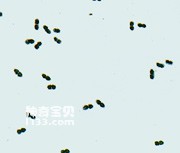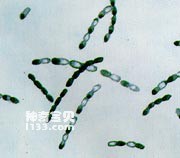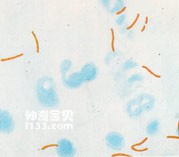When people think of bacteria, the first thing that people think of are probably those pathogenic bacteria that cause diseases and destroy lives. Therefore, it is inevitable to talk about bacteria. In fact, pathogenic bacteria are only a part of bacteria, and in the vast world of bacterial families, most bacteria can bring great benefits to humans. The production of food additives such as MSG and the purification of the environment are inseparable from bacteria.
Bacteria are a type of single-celled organisms with a simple structure. They are so small that they can only be observed with a microscope. It does not have a formed nucleus, and only some nucleoplasm is either dispersed in the protoplasm of the cell, or exists in a granular state. Therefore, scientists call them "prokaryotes."
There are many types of bacteria and they are extremely widely distributed. There are traces of bacteria everywhere from an altitude of 17 kilometers on the earth to a depth of 10,700 meters in the ocean.
Bacteria are not only widely distributed, but also of many types and have different appearances. Scientists usually divide them into four groups based on their appearance: spherical ones are called cocci, long cylindrical ones are called bacilli, and those with slightly curved or arched cells are called Vibrio, the spiral-shaped ones are called spirobacteria, also called spirochetes.

pneumococci
Among the cocci, some are solitary and are called single cocci, such as Pediococcus urea; some are in pairs, called diplococci, such as Diplococcus pneumoniae; and some have 4 cells connected together, called tetracocci. Synecoccus; some 8 bacterial cells are stacked together like a "stacked Arhat", which is called Sarcina, such as Sarcina luteus; some bacteria are connected together like a string of beads, which is called Sarcina cocci. Streptococci, such as Streptococcus lactis; other bacteria gather together irregularly and look like bunches of grapes, becoming staphylococci, such as Staphylococcus aureus.
Bacilli are further divided into long bacilli (such as Mycobacterium tuberculosis), short bacilli (such as glutamate-producing bacteria) and medium-sized bacilli (such as Escherichia coli). Some rod-shaped bacteria can be linked together. Such bacteria are called streptobacteria (such as Bacillus anthracis). Some bacilli can grow side branches, and such bacilli are called mycobacteria (such as Mycobacterium tuberculosis).

Bacillus anthracis

Mycobacterium tuberculosis
In addition to the above four groups, there is also a type of filamentous bacteria whose rod-shaped cells are connected into long chains and surrounded by a common sticky sheath, forming filamentous or hair-like hyphae. Such bacteria are called sheath-coated bacteria and are commonly found in sewers or other water rich in organic matter.
If we cut a bacterium and observe it, the outermost layer of the bacterium is a strong protective layer called the cell wall, which surrounds the entire bacterial body and gives the cell a fixed shape. Its main component is peptidoglycan. Inside the cell wall is a thin, soft and elastic permeable membrane - the cell membrane. It is the exchange station inside and outside the cell, controlling the exchange of materials inside and outside the cell. The cell membrane is composed of lipids, proteins and sugars, and inside it is the cytoplasm, the vital material of the bacteria. The cytoplasm is composed of a viscous gelatinous material containing various enzyme systems. It is the site of biochemical reactions and a "warehouse" for storing metabolic products. Its chemical components are mainly water, proteins, nucleic acids, and lipids. There is a nuclear region in the cytoplasm of bacteria, but this "nucleus" is different from the nucleus of eukaryotes. It is not surrounded by a nuclear membrane and is only made of coiled genetic material. Its chemical composition is mainly nucleic acid.
In addition to the general cell structure, some bacteria also have some special structures, such as capsules, spores, flagella, etc.
The capsule is a jelly-like mucus-like membrane outside the cell wall of some bacteria, which can resist harmful chemicals from invading the bacteria. Therefore, encapsulated bacteria are not easily killed by drugs. The composition of the capsule varies from bacterium to bacterium, with most being polysaccharides or polypeptides.
Some bacteria can form a round or oval endospore called a spore from within the vegetative cell at a certain stage of their life activities. Spores are dormant bodies of bacteria with low water content, thick and dense walls, and strong resistance to heat, dryness and damage from chemicals. Spores can exist independently from cells and can survive for up to 10 years in a dry environment. When conditions are suitable, the spores will germinate and grow into new bacteria. But spores are not the way to reproduce offspring, because one bacterial cell can only produce one spore. Bacteria reproduce by cell division.
Some bacilli and vibrios can also grow very thin and long filaments called "flagella". The flagellum is a motor organ deeply embedded in the cytoplasm. The rotation of the flagellum can propel bacteria to move rapidly. Cocci usually don't have flagella, some bacilli have them, some don't, and some have them only at a certain stage of their growth. Both Vibrio and Spiral bacteria have flagella. Some bacteria, such as spirochetes, do not use flagella to move, but use the elastic axonemes in the cells to stretch and contract to move the bacteria.
animal tags: bacteria
We created this article in conjunction with AI technology, then made sure it was fact-checked and edited by a Animals Top editor.